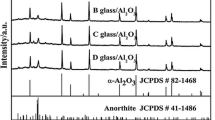Abstract
To relieve the camber of Au/ceramic co-fired structure, investigation on the sintering of gold paste with different constituent material properties was performed in this study. The sintering initial temperature of gold paste was correlated with the gold particle size, the glass softening point and the glass content closely. By adjusted the gold paste sintering shrinkage behaviour the camber evolutions were obviously changed, including the camber direction and the camber degree. When glass content in gold paste was 3 wt% and the softening point was 730 °C, the Au/ceramic co-fired structure exhibited the minimum camber, of which the ht/ho value was 0.96. The results of this work have shown the relationship between the camber evolution of Au/ceramic structure and the sintering shrinkage behaviour of gold paste, which would give an avenue to solve camber in the LTCC application.











Similar content being viewed by others
References
Y. Li, D. Goyal, 3D microelectronic packaging: from fundamentals to applications (Springer, Berlin, 2017)
H. Young Jun, D.S. Jung, H.Y. Koo, J.H. Kim, Y.N. Ko, K. Yun Chan, Characteristics of ZnO–B2O3–SiO2–CaO glass frits prepared by spray pyrolysis as inorganic binder for Cu electrode. J. Alloys Compd. 509, 8077–8081 (2011)
J. Raynaud, V. Pateloup, M. Bernard, D. Gourdonnaud, D. Passerieux, D. Cros, T. Chartier, Hybridization of additive manufacturing processes to build ceramic/metal parts: example of LTCC. J. Eur. Ceram. Soc. 40, 759–767 (2020)
M. Jianli, F. Zhifen, L. Peng, W. Bing, L. Yang, Microwave dielectric properties of low-fired Li2TiO3–MgO ceramics for LTCC applications. Mater. Sci. Eng. B 204, 15–19 (2016)
X. Yao, H. Jiao, L. Yuanming, L. Shihong, Y. Shuang Wu, Y. Xu, Z. Ming, Z. Limin, H. Zihan, Glass structure, phase transformation and microwave dielectric properties of CaO–B2O3–SiO2 glass-ceramics with addition of La2O3. J. Mater. Sci.: Mater. Electron. 28, 9911–9918 (2017)
R. Haishen, D. Mingzhao, W. Huijun, X. Tianyi, J. Shaohu, L. Huixing, L. Lan, Sintering behavior and microwave dielectric properties of B2O3–La2O3–MgO–TiO2 based glass–ceramic for LTCC applications. Mater. Lett. 210, 113–116 (2018)
M. Haijun, C. Xingyu, W. Fenglin, Z. Weijun, Effects of alkaline earth oxides on the densification and microwave properties of low-temperature fired BaO–Al2O3–SiO2 glass–ceramic/Al2O3 composites. J. Mater. Sci. 54, 12371–12380 (2019)
G.Q. Lu, R.C. Sutterlin, T.K. Gupta, Effect of mismatched sintering kinetics on camber in a low temperature cofired ceramic package. J. Am. Ceram. Soc. 76, 1907–1914 (1993)
C. Jui-Chuan, J. Jau-Ho, Camber development during the cofiring of Bi–layer glass-based dielectric laminate. J. Am. Ceram. Soc. 88, 1165–1170 (2005)
L. Yun-Chiang, J. Jau-Ho, Constrained Sintering of Silver Circuit Paste. J. Am. Ceram. Soc. 87, 187–191 (2004)
A. Heux, G. Antou, N. Pradeilles, N. Delhote, C. Karnfelt, F. Gallee, A. Maître, Sintering and thermomechanical behavior of a low temperature co–fired ceramic. Ceram. Int. 44, 22609–22615 (2018)
J.W. Choe, J.N. Calata, G.Q. Lu, Constrained-film sintering of a gold circuit paste. J. Mater. Res. 10, 986–994 (1995)
T.J. Garino, H.K. Bowen, Kinetics of constrained-film sintering. J. Am. Ceram. Soc. 73, 251–257 (1990)
A. Jagota, C.Y. Hui, Mechanics of sintering thin films–I. Formulation and Analytical Results. Mech. Mater. 9, 107–119 (1990)
A. Jagota, C.Y. Hui, Mechanics of sintering thin films–II. Cracking due to self-stress. Mech. Mater. 11, 221–234 (1991)
Y. Tingnan, Z. Weijun, C. Xingyu, L. Zhuofeng, M. Haijun, W. Fenglin, Improvement of gold electrode conductivity after cofiring with CaO–B2O3–SiO2 green tapes for LTCC application. Ceram. Int. 46, 493–499 (2020)
Y. Tingnan, Z. Weijun, C. Xingyu, W. Fenglin, B. Shuxin, Sintering densification behaviors and crystallization characteristics of glass–ceramics formed by two types of CaO–B2O3–SiO2 glass. J. Mater. Sci.: Mater. Electron. 30, 1–8 (2019)
Lutz K, Golla M (1975) Process for the production of gold powder, US Patent 3885955.
S. Iwama, K. Hayakawa, Sintering of ultrafine metal powders. II. Neck growth stage of Au, Ag, Al and Cu. Jpn. J. Appl. Phys. 20, 335–340 (1981)
Z. Haiyang, F. Renli, S. Agathopoulos, F. Jun, L. Guojun, H. Qinjiang, Crystallization behaviour and properties of BaO–CaO–B2O3–SiO2 glasses and glass–ceramics for LTCC applications. Ceram. Int. 44, 10147–10153 (2018)
S. Liangbo, L. Chunfeng, F. Jian, Z. Jie, L. Chengjie, Crystallization behavior and thermal properties of B2O3–containing MgO–Al2O3–SiO2–Li2O glass–ceramic and its wettability on Si3N4 ceramic. J. Eur. Ceram. Soc. 39, 1532–1539 (2019)
Q. Jun, Z. Weijun, B. Shuxin, L. Zhuofeng, Study on the sintering and contact formation process of silver front side metallization pastes for crystalline silicon solar cells. Appl. Surf. Sci. 376, 52–61 (2016)
Y. Imanaka, Multilayered low temperature cofired ceramics (LTCC) technology (Springer, Boston, 2005)
Acknowledgements
This work was funded by National Natural Science Foundation of China (Grant No. 11705281), The Natural Science Foundation of Hunan Province of China (Grant No. 2018JJ3602) and the Research Project of National University of Defense Technology (ZK18-03-51).
Author information
Authors and Affiliations
Corresponding authors
Ethics declarations
Conflict of interest
The authors declare that they have no conflict of interest.
Additional information
Publisher's Note
Springer Nature remains neutral with regard to jurisdictional claims in published maps and institutional affiliations.
Rights and permissions
About this article
Cite this article
Yan, T., Chen, X., Zhang, W. et al. Decrease in the camber degree of Au/ceramic co-fired structure for LTCC technology. J Mater Sci: Mater Electron 31, 17225–17232 (2020). https://doi.org/10.1007/s10854-020-04277-8
Received:
Accepted:
Published:
Issue Date:
DOI: https://doi.org/10.1007/s10854-020-04277-8




